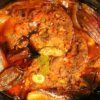Gallbladder Function
The gallbladder mucosa is lined with a single layer of columnar epithelial cells that, in many species, secondarily form prominent folds that can reach into the muscular layer, forming Rokitansky–Aschoff sinuses.
Correspondingly, What is Calot’s triangle? Calot triangle or cystohepatic triangle is a small (potential) triangular space at the porta hepatis of surgical importance as it is dissected during cholecystectomy. Its contents, the cystic artery and cystic duct must be identified before ligation and division to avoid intraoperative injury.
What tissues are in gallbladder? The gallbladder is made up of layers of tissue:
- mucosa – the inner layer of epithelial cells (epithelium) and lamina propria (loose connective tissue)
- a muscular layer – a layer of smooth muscle.
- perimuscular layer – connective tissue that covers the muscular layer.
- serosa – the outer covering of the gallbladder.
Furthermore, Why there is no submucosa in gallbladder?
The gallbladder does not have a true submucosa. Rather, it has a muscularis in which the muscle layers are interspersed with connective tissue fibers. An adventitia surrounds the gallbladder where it lies against the liver and a serosa is present where it’s not in contact with other organs.
What are the histological layers of the gallbladder wall?
The gallbladder wall consists of three layers: mucosa, muscularis, and serosa.
What is mirizzi? Mirizzi syndrome is defined as common hepatic duct obstruction caused by extrinsic compression from an impacted stone in the cystic duct or infundibulum of the gallbladder [1-3]. Patients with Mirizzi syndrome can present with jaundice, fever, and right upper quadrant pain.
What is in the hepatoduodenal ligament? The hepatoduodenal ligament runs from the porta hepatis to the proximal 2 cm of the duodenum. The hepatic artery proper, common bile duct, and portal vein run through the ligament near its free edge to reach the liver. These three structures are often referred to as the portal triad.
What is the Hepatocystic triangle? The hepatocystic triangle is defined as the triangle formed by the cystic duct, the common hepatic duct, and inferior edge of the liver. The common bile duct and common hepatic duct do not have to be exposed. The lower one third of the gallbladder is separated from the liver to expose the cystic plate.
What is the function of gallbladder?
Your gallbladder is part of your digestive system. Its main function is to store bile. Bile helps your digestive system break down fats. Bile is a mixture of mainly cholesterol, bilirubin and bile salts.
What happens if gallbladder is removed? Living without a gallbladder
You can lead a perfectly normal life without a gallbladder. Your liver will still make enough bile to digest your food, but instead of being stored in the gallbladder, it drips continuously into your digestive system.
Which epithelium is found in gallbladder?
So, the correct answer is ‘brush border columnar epithelium‘.
What is a Cholangiocyte? Cholangiocytes are epithelial cells lining the intrahepatic and extrahepatic bile ducts; they are heterogeneous in size and function and contribute to bile composition and flow by solute transport processes.
What’s a porcelain gallbladder?
Porcelain gallbladder refers to the condition in which the inner gallbladder wall is encrusted with calcium. The wall becomes brittle, hard, and often takes on a bluish hue. Other names for this condition are calcified gallbladder, calcifying cholecystitis, and cholecystopathia chronica calcarea.
What is hydrops of gallbladder?
Mucocele (hydrops) of the gallbladder is a term denoting an overdistended gallbladder filled with mucoid or clear and watery content. The condition can result from gallstone disease, the most common affliction of the biliary system.
What does gallbladder wall thickening indicate? Thickening of the gallbladder wall is a relatively frequent finding on diagnostic imaging studies. Historically, a thick-walled gallbladder has been regarded as proof of primary gallbladder disease, and it is a well-known hallmark feature of acute cholecystitis.
What is the normal gallbladder wall thickness? The normal gallbladder wall is less than 3 mm thick, shows low intensity on T2 and intermediate on T1 weighted sequences, and enhances homogeneously after the administration of intravenous contrast 6.
What is lined by a serosa?
Serosa lines the peritoneal cavity, pericardial cavity and pleural cavity. Mucosa lines the alimentary canal, genitourinary tract and respiratory tract.
What is Cholecystoduodenal fistula? Cholecystoduodenal fistula is a complication of gallstones that causes bowel obstruction, cholangitis, weight loss, and other nonspecific symptomatology. Although it is rare, this fistula should be contemplated in elderly patients and in cases of porcelain gallbladder with multiple adhesions.
What is Cholecystoenteric fistula?
Cholecystoenteric fistula is a rare complication of biliary disease. The fistula usually results from inflammation associated with acute cholecystitis and occurs between the gallbladder and an adjacent hollow viscus.
What is in the Hepatogastric ligament? The hepatogastric ligament or gastrohepatic ligament connects the liver to the lesser curvature of the stomach. It contains the right and the left gastric arteries. In the abdominal cavity it separates the greater and lesser sacs on the right. It is sometimes cut during surgery in order to access the lesser sac.
Is vagus nerve in hepatoduodenal ligament?
Additional anatomical structures are present within the hepatoduodenal ligament. A branch of the vagus nerve runs throughout the ligament next to the portal triad.
What is Gastrophrenic ligament? Gastrophrenic ligament. (Science: anatomy) The portion of the greater omentum that extends from the greater curvature of the stomach to the inferior surface of the diaphragm. Synonym: ligamentum gastrophrenicum, gastrodiaphragmatic ligament, phrenogastric ligament.




